What Is The Garnet Birthstone?

The red garnet is a gemstone steeped in rich history and powerful symbolism across various cultures. Its deep, blood-red color has made it a focal point of meaning for centuries.
Let's see these tables of contents.
What Is The Garnet Birthstone?
What Does The Red Garnet Birthstone Symbolize?
How to Accurately Identify Garnet Gemstones?
What Is The Rarest Color Of the Garnet Birthstone?
How Can I Test My Garnet Birthstone At Home?
How To Tell If It's A Ruby Or Garnet Birthstone?
Is Garnet Considered A Precious Stone?
How Much Is 1 Carat Of Garnet Birthstone?
Here is the first topic of content.
What Is The Garnet Birthstone?
Garnet is the primary birthstone for January. This association is recognized globally by major gemological and jewelry organizations.
Here's a breakdown of key details:
Official Birthstone Status
Modern Lists:
Jewelers of America (JA), American Gem Society (AGS), and the National Association of Goldsmiths (UK) all designate garnet as January's birthstone.
Ancient Tradition:
Egyptians (1500 BCE) and medieval Europeans linked garnet to January for its protective qualities during winter.
What Garnet Represents for January Birthdays
Symbolism:
Protection & Strength
Vitality & Renewal (aligned with the new year).
Commitment (traditional 2nd wedding anniversary gift).
Color Range:
While deep red is classic, January babies can claim all garnet colors:
Green (tsavorite), orange (spessartine), purple (rhodolite), and rare blue.
Zodiac Connections
Capricorn (Dec 22–Jan 19): Enhances ambition and grounding.
Aquarius (Jan 20–Feb 18): Boosts innovation and social connections.
How January Babies Can Wear It
Right hand: To project confidence and energy.
Left hand: To receive protection and emotional balance.
Pair with:
Gold for warmth and luxury.
Silver for modern, calming vibes.
Note on Other Months
Garnet was historically linked to January only. Some older lists associated it with February or Aquarius, but this is outdated.
January has no alternative birthstones—garnet stands alone.

What Does The Red Garnet Birthstone Symbolize?
Of course. The red garnet is a gemstone steeped in rich history and powerful symbolism across various cultures. Its deep, blood-red color has made it a focal point of meaning for centuries.
Here’s a breakdown of what the red garnet symbolizes:
Primary Symbols and Meanings
Passion, Energy, and Vitality
The most immediate association with red garnet is its vibrant, life-force energy. It symbolizes:
Unwavering Passion: For life, love, and creative pursuits.
Strength and Vigor: It is considered a talisman for revitalization, boosting energy levels, and overcoming fatigue and lethargy.
Sensuality: Its deep red hue makes it a stone of intimate connection and desire.
Commitment and Devotion
Due to its historical use as a gift between friends and lovers separated by distance, garnet is a powerful symbol of:
Faithful Love: It represents deep, enduring affection and the promise of reunion. Victorians often used garnet in romantic jewelry.
Friendship: It signifies loyalty and trust between companions.
Constancy: The stone is believed to help maintain commitment and see relationships through challenging times.
Protection and Safety
This is one of the oldest and most universal symbols of garnet.
A Talisman Against Harm: Ancient warriors carried garnet for protection in battle. Travelers wore it to ensure a safe journey.
Psychic Protection: It's believed to create a protective shield around the body, guarding against negative energy, evil spirits, and nightmares.
Emotional Security: It provides a sense of safety and grounding during times of emotional turmoil or change.
- Prosperity and Success
Manifestation: Garnet is recognized as a stone of manifestation, facilitating the transformation of visions and dreams into reality.
Career Success: It's thought to attract wealth and boost one's business prospects, especially for those in leadership or entrepreneurial roles.
Abundance: Its energy is said to help attract all the necessary resources for a prosperous and comfortable life.
- Regeneration and Strength
Inner Fire: Garnet is symbolically linked to the root and sacral chakras, which govern our sense of survival, vitality, and creative power. It is said to ignite an inner fire that fuels courage and determination.
Overcoming Adversity: It symbolizes the strength to overcome challenges, past trauma, and feelings of victimhood. It empowers the wearer to take control of their life.
Cultural and Historical Symbolism
Ancient Egypt: Pharaohs wore garnet necklaces for protection in this life and the afterlife. It was considered a symbol of life and power.
Ancient Rome: Romans used garnet in signet rings to stamp wax seals on important documents, symbolizing authority and truth.
The Bible: Some scholars believe the "carbuncle" mentioned in the Bible as one of the stones in Aaron's breastplate was actually a red garnet, symbolizing light and guidance.
Medieval Europe: Knights carried garnets for protection in battle, and it was believed to light up the night and protect its bearer from poisoning.
Asian Cultures: In Indian and Chinese traditions, garnet was a popular talisman for prosperity and protection, often used in trade as a symbol of good fortune.
In Summary:
For a woman (or anyone) wearing a red garnet, it can symbolize:
A strong, passionate, and committed heart.
The vitality and courage to pursue one's dreams.
A protective shield against negativity.
The attraction of success and abundance.
A deep connection to one's inner strength and power.
Ultimately, while its traditional meanings are powerful, it is the most personal symbolism that resonates with the wearer. Many choose garnet not just for its beauty, but for the intention of inviting these powerful energies into their lives.

How to Accurately Identify Garnet Gemstones?
To identify a genuine garnet, use a combination of visual checks and simple tests. Here’s a step-by-step guide:
Visual Inspection
Color Range:
Garnet stones occur in red, pink, green, orange, yellow, purple, and even blue (rare). Dark red is common, but don’t dismiss green or orange stones!
Luster: Look for a glassy (vitreous) shine – not overly sparkly like cubic zirconia.
Inclusions:
Natural garnets often contain:
Needle-like crystals (almandine).
"Horsetail" inclusions (demantoid).
Rounded crystals or color zoning.
Avoid stones with bubbles (indicates glass) or perfect clarity (common in synthetics).
Simple Home Tests
Test How to Do It Garnet Result
Hardness Test: Scratch glass or a copper penny with the stone. ✅ Scratches glass (Mohs 6.5–7.5).
Scratches copper.
Magnet Test: Use a strong neodymium magnet. Garnet contains iron/manganese. ✅ Slight attraction (especially almandine/pyrope).
UV Light Shine a blacklight on the stone. ❌ Usually inert (no glow). Exception: Some red garnets faintly glow red.
Heft Test: Compare the weight to similar-sized gems. ✅ Feels heavier than glass or quartz.
Advanced Clues (Require Tools)
Refractometer:
Garnet’s Refractive Index (RI) ranges from 1.72 to 1.94 (higher than quartz or glass).
Spectroscope:
Red garnets show strong bands in yellow-green; green garnets (e.g., tsavorite) show chromium lines.
Pleochroism:
Garnets are singly refractive (no color change when tilted). Rubies/sapphires show dual colors.
Common Garnet Imitations & Red Flags
Fake: How to Spot It
Glass bubbles are lightweight and scratch easily.
Synthetic Spinel Bright UV glow, too clean.
Cubic Zirconia Extreme sparkle, high dispersion ("fire").
Garnet Doublet Layered structure visible at the girdle.
Key Garnet Traits Summary
Property Garnet Signature
Color: All colors except pure blue (ultra-rare).
Magnetism: Weakly magnetic (test with a strong magnet).
Inclusions: Natural flaws (needles, crystals, "horsetails").
Density Heavy for its size (SG 3.5–4.3).
When to Suspect It’s NOT Garnet
It scratches easily with a knife (hardness <6.5).
Shows strong fluorescence (blue/green = synthetic spinel).
Has rainbow-like "fire" (indicates CZ or diamond simulant).

What Is The Rarest Color Of the Garnet Birthstone?
The rarest colors of garnet birthstone are blue and intense emerald-green (uvarovite), followed by distinct color-change varieties. Here's a breakdown:
Blue Garnet Birthstone:
Extreme Rarity: True blue garnets are among the rarest gems on Earth.
Cause: The blue color is primarily due to vanadium (sometimes with chromium) and requires very specific geological conditions. They are almost exclusively a color-change garnet.
Phenomenon: These garnets dramatically change color under different light sources. The most prized shift is blue or blue-green in daylight to reddish-purple or purple under incandescent light. Less dramatic shifts (e.g., greenish to brownish) are more common but still rare.
Source: The most significant source of these rare color-change blue garnets has been Bekily, Madagascar. Small amounts have been found elsewhere, but Madagascar produces the finest examples.
Uvarovite (Emerald-Green Garnet):
Rarest Garnet Species: Uvarovite is the rarest of the main garnet species in gem-quality form.
Color: It's known for its rich, vibrant emerald green color caused by chromium.
Challenge: It rarely forms large, transparent crystals suitable for faceting. It typically occurs as druzes (sparkling coatings) of tiny crystals or very small embedded crystals.
Result: Finding a clean, facetable piece of uvarovite large enough to cut even a small gem (e.g., 0.5 carats) is exceptionally rare and valuable. Most "uvarovite" in jewelry is actually drusy material set in a matrix.
Why Other "Rare" Colors Aren't Necessarily the Rarest:
Demantoid (Green): Rare and valuable, especially with "horsetail" inclusions, but more available than uvarovite or blue color-change. Found in larger, facetable crystals.
Tsavorite (Green): A vibrant green grossular garnet (chromium/vanadium colored). While rare and valuable, it's significantly more available than uvarovite or blue color-change garnets. Major sources exist (Kenya, Tanzania).
Malaia/Malaya (Pinkish-Orange, Peach): A rare and desirable garnet, but still found more frequently than the top two.
Rhodolite (Purplish-Red): Popular and valuable, but relatively common compared to the extremes listed above.
Red Garnets (Pyrope, Almandine): The most common and widely available garnet colors.
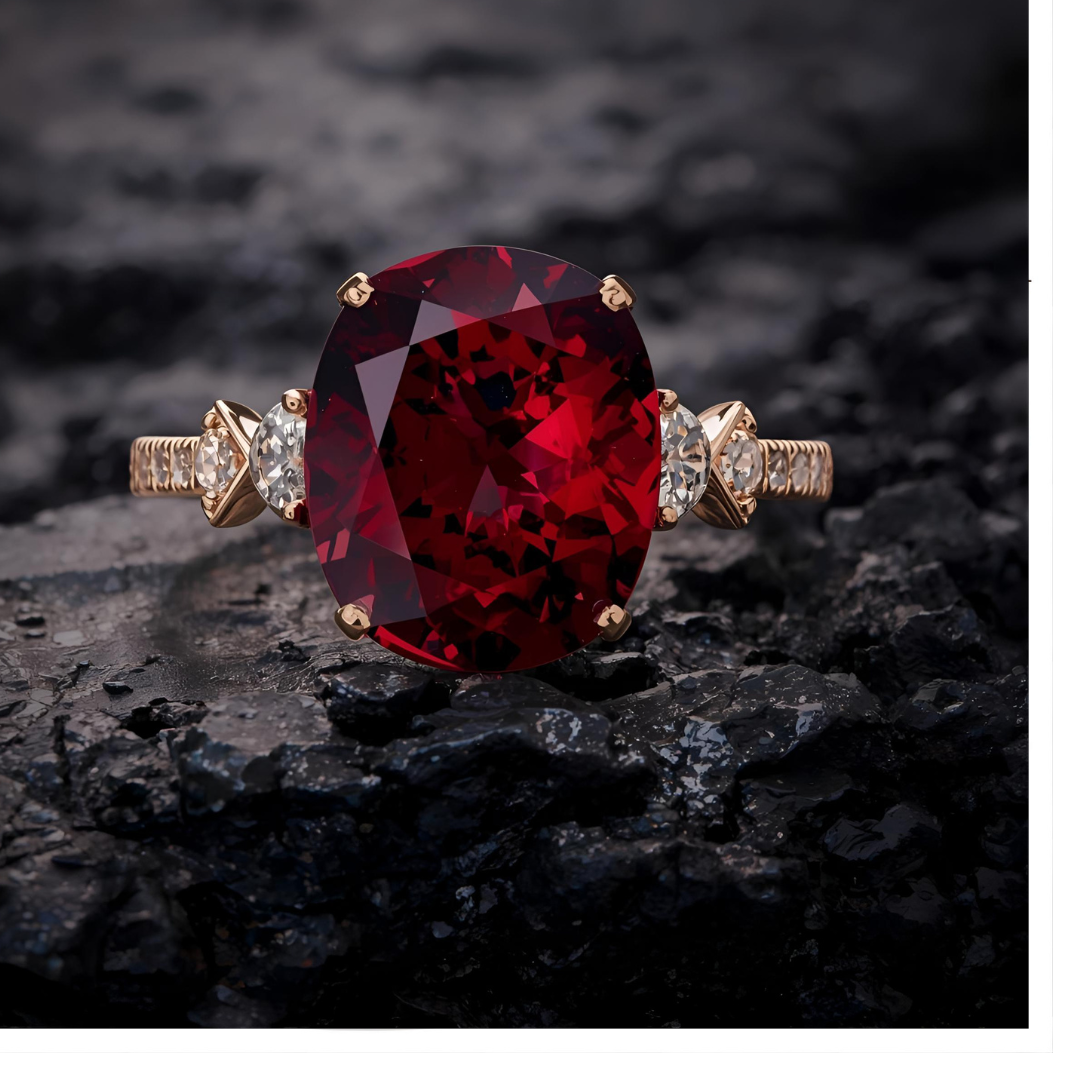
How Can I Test My Garnet Birthstone At Home?
Garnet is the primary birthstone for January.
Testing garnet at home involves a combination of visual inspection and simple physical tests to distinguish it from common imitations (like glass or synthetic gems). While professional gemological testing is best for certainty, these methods can help you identify genuine garnet:
Visual Inspection (Essential First Step)
Color & Shine:
Garnets are rarely "perfect." Look for slight color zoning (subtle variations in color intensity).
Natural garnets have a rich, vitreous (glass-like) luster—not overly sparkly like cubic zirconia.
Inclusions:
Most garnets contain natural inclusions (e.g., needle-like crystals, "horsetail" inclusions in demantoid, or rounded crystals).
Glass imitations often have bubbles or swirl marks.
Check for Wear:
Garnet (Mohs hardness: 6.5–7.5) is durable but may show scratches on facets if worn daily. Glass scratches more easily.
Basic Tools for Home Testing
Magnifying Loupe (10x):
Inspect for inclusions, bubbles, or abrasions (glass/synthetics often look "too clean").
UV Light (Blacklight):
Some garnets (e.g., red almandine) may show weak red fluorescence.
Glass usually does not fluoresce; synthetics may glow brightly.
Refractometer (If available):
Garnet’s refractive index (RI) ranges from 1.72 to 1.94 depending on type. Glass RI is typically lower (1.52–1.70).
Physical Tests
Thermal Conductivity (Touch Test):
Garnet feels colder than glass/plastic when touched to your lip or eyelid.
Note: Not foolproof but useful for spotting plastic/glass fakes.
Weight Test (Heft):
The January birthstone is denser than glass. Compare similar-sized stones—garnet will feel heavier.
Scratch Test (Use Caution):
Garnet can scratch glass (since it’s harder).
Method: Press the stone firmly against a glass bottle; a real garnet will leave a faint scratch.
Do not scratch your gem! Test only on expendable material.
Common Garnet Imitations & How to Spot Them
Imitation: How to Differentiate from Garnet
Glass Bubbles, low heft, scratches easily, no inclusions.
Synthetic Spinel Often too clean, UV fluorescence (bright blue/green).
Plastic Warm to the touch, very light, low luster.
Cubic Zirconia Extreme sparkle, higher dispersion ("fire"), no inclusions.
What Home Tests CAN’T Tell You
Garnet Type: Tests won’t distinguish almandine from pyrope, etc.
Origin or Treatment: Requires lab equipment (e.g., spectroscopy).
Synthetics: Some lab-grown garnets look identical to natural ones.
When to Consult a Professional
Seek a gemologist if:
The stone is large or valuable.
You suspect a rare variety (e.g., tsavorite, demantoid, color-change).
Home tests are inconclusive.
Pro Tip: For $50–$100, gem labs (e.g., GIA) offer basic identification reports.
Always handle gems gently—even garnet can chip if dropped!

How To Tell If It's A Ruby Or Garnet Birthstone?
Distinguishing between ruby (red corundum) and red garnet (typically almandine or pyrope) can be tricky due to similar colors, but these key differences will help you tell them apart:
Quick Visual Clues:
Feature Ruby Garnet (Red Types)
Color Tone Vivid pinkish-red to blood-red; often has "blueish" undertones. Deeper burgundy, brownish-red, or purplish-red; rarely "pure" red.
Shine/Luster Bright, vitreous to subadamantine sparkle. Softer, glass-like (vitreous) luster; less "fire."
Inclusions: Silk (rutile needles), fingerprints, zoning. Curved striae, rounded crystals, "horsetails" (demantoid).
Transparency is often slightly included; eye-clean is rare. Commonly transparent with fewer visible flaws.
Simple Home Tests:
Hardness Test (Use Caution):
Ruby (Mohs 9) scratches quartz (7), topaz (8), and even sapphire (9).
Garnet (Mohs 6.5–7.5) scratches glass but won’t scratch quartz/topaz.
→ Test: Try scratching an unimportant quartz crystal (e.g., cheap tumble). Ruby will scratch it; garnet won’t.
UV Light Test:
Ruby: Glows strong red under UV (blacklight).
Garnet: Usually inert (no glow) or faint red (almandine).
Weight/Heft:
Garnet is denser (SG 3.5–4.3) than ruby (SG 4.0).
→ A garnet feels heavier than a same-sized ruby.
Sparkle/Fire:
Ruby has a higher refractive index (1.76–1.78) vs. garnet (1.72–1.94).
→ Ruby appears brighter; garnet looks "softer."
Advanced Methods (Gemologist Tools):
Double Refraction (DR):
Ruby is doubly refractive (shows doubling of facet edges under 10x loupe). Garnet is singly refractive.
Spectroscope:
Ruby shows distinct chromium lines (692nm, 668nm, 659nm); garnet has a stronger "yellower" spectrum.
Synthetics & Imitations:
Lab-grown ruby is common and hard to ID without magnification (look for curved striae or gas bubbles).
Garnet-doublets (glass topped with garnet) can mimic ruby – check for layered structure at the girdle.
Summary Table:
Test Ruby Garnet
Scratches Quartz Yes ❌ No
UV Fluorescence Bright red None/faint
Density Lighter (SG ~4.0) Heavier (SG 3.5–4.3)
Color Undertones Pink/blue Purple/brown
Inclusions Rutile "silk" Rounded crystals
When to See a Pro:
If the stone is large or valuable.
If tests are inconclusive.
For certification (e.g., GIA report).
→ Cost: $50–$150 for a gem ID.

Is Garnet Considered A Precious Stone?
Garnet is traditionally classified as a semi-precious stone—but this label is outdated and doesn’t reflect its true value or rarity. Here’s a clear breakdown:
Historical "Precious vs. Semi-Precious" Classification
Precious Stones Semi-Precious Stones
Diamond, Ruby, Emerald, Sapphire. All other gemstones (including garnet, amethyst, topaz, etc.)
Why garnet fell into "semi-precious":
Common red varieties (almandine, pyrope) were historically abundant and affordable.
The term originated in the 19th century when only four gems were deemed "precious."
Modern Reality: Garnet Defies Old Labels
While garnet isn’t part of the "big four," rare types rival "precious" gems in value and prestige:
Tsavorite Garnet Birthstone (vivid green): Often compared to emerald, but rarer in large sizes.
Demantoid Garnet Birthstone (emerald-green): Can exceed $10,000/carat (especially with "horsetail" inclusions).
Color-Change Garnet Birthstone (blue to purple): Among the rarest gems on Earth.
Top-tier garnets now sell for prices comparable to sapphires or emeralds, blurring the old categories.
Why Gemologists Reject "Semi-Precious"
Arbitrary Distinction:
A rare garnet (e.g., 5-ct tsavorite) is far more valuable than a low-quality "precious" sapphire.
Rarity-Driven Value:
Demantoid is rarer than 99% of sapphires.
Blue garnet is rarer than most diamonds.
Market Shift:
Auction houses (e.g., Christie’s, Sotheby’s) sell elite garnets alongside rubies and emeralds.
Value Comparison (Per Carat)
Gemstone High-Quality Price Range
Demantoid Garnet $2,000–$20,000+
Tsavorite Garnet $1,000–$8,000+
Commercial Emerald $500–$5,000+
Common Garnet (Red) $5–$100
Key Takeaway:
No, garnet isn’t one of the four "precious stones" by traditional definition.
Yes, its rarest varieties are equally valuable and coveted—making the "semi-precious" label misleading.
If you own a garnet, judge it by:
Color intensity (vivid green > dark red),
Clarity & size (eye-clean + >2 carats = premium),
Rarity (tsavorite/demantoid > almandine).
Fun fact: The Smithsonian’s collection features garnets alongside the "precious" gems—proof that beauty and rarity transcend old categories!

How Much Is 1 Carat Of Garnet Birthstone?
The value of 1 carat of garnet varies dramatically based on its type, color, clarity, and origin, from $5 to over $20,000 per carat.
Below is a detailed breakdown:
Garnet Value per Carat (1ct) by Type
Garnet Type Color Price Range (1ct) Key Factors
Demantoid Vivid Green $1,000 – $20,000+ "Horsetail" inclusions boost value; Russian origin commands a rpremium
Tsavorite Emerald Green $800 – $8,000+ Clean stones >1ct rare; intense color and clarity drive price.
Color-Change Blue-Green → Red $500 – $15,000+ Extreme rarity (Madagascar origin = highest value).
Spessartine Vibrant Orange $200 – $3,000+ "Mandarin" garnets (clean, saturated color).
Malaia/Malaya Peach-Pink $100 – $2,500+ Collector demand for unique hues.
Rhodolite Raspberry-Purple $50 – $800 Popular in jewelry; deeper purple = higher value.
Pyrope Blood Red $10 – $200 Classic garnet; larger, clean stones cost more.
Almandine Deep Burgundy $5 – $100 Most abundant; often used in affordable jewelry.
Uvarovite Chrome Green $100 – $1,500* *Usually tiny crystals; facetable >0.5ct is rare.
Synthetic/Lab-Grown Any $1 – $50 (e.g., YAG—Yttrium Aluminum Garnet).
Critical Factors Affecting Value
Color:
Greens (tsavorite, demantoid) > Oranges (spessartine) > Purples (rhodolite) > Reds (pyrope/almandine).
Example: A vivid green tsavorite is 100× more valuable than a dark red almandine.
Clarity:
Eye-clean stones cost 2–5× more than included ones (except demantoid with prized "horsetails").
Cut:
Precision cuts (e.g., hearts & arrows) add 20–50% value vs. commercial cuts.
Size:
Prices jump exponentially above 1ct (e.g., a 2ct tsavorite may cost 3× more per carat than a 1ct stone).
Origin:
Russian demantoid or Kenyan tsavorite can add 30–100% premiums.
Real-World Examples
$10: 1ct dark red almandine (common, included).
$150: 1ct clean pyrope (vivid red).
$2,500: 1ct "mandarin" spessartine (vibrant orange, eye-clean).
$6,000: 1ct tsavorite (medium green, minor inclusions).
$15,000+: 1ct demantoid with "horsetail" inclusions (Russian).
Red Flags for Low-Value Garnets
Glass imitations: $0.50–$5/ct (bubbles, low hardness).
Dyed stones: Uneven color, fades over time.
Misleading names: "Arizona ruby," "Cape ruby" = garnet (worth 1/100th of real ruby).
Practical Advice
For jewelry: Common red garnets ($10–$50/ct) offer beauty on a budget.
For investment: Focus on green tsavorite/demantoid or color-change garnets >2ct with lab reports (e.g., GIA).
Verify authenticity: Use tests from your previous guide or get a $50 gem lab report.
What Wearing a Garnet Ring Reveals: Insights into Its History and Meaning
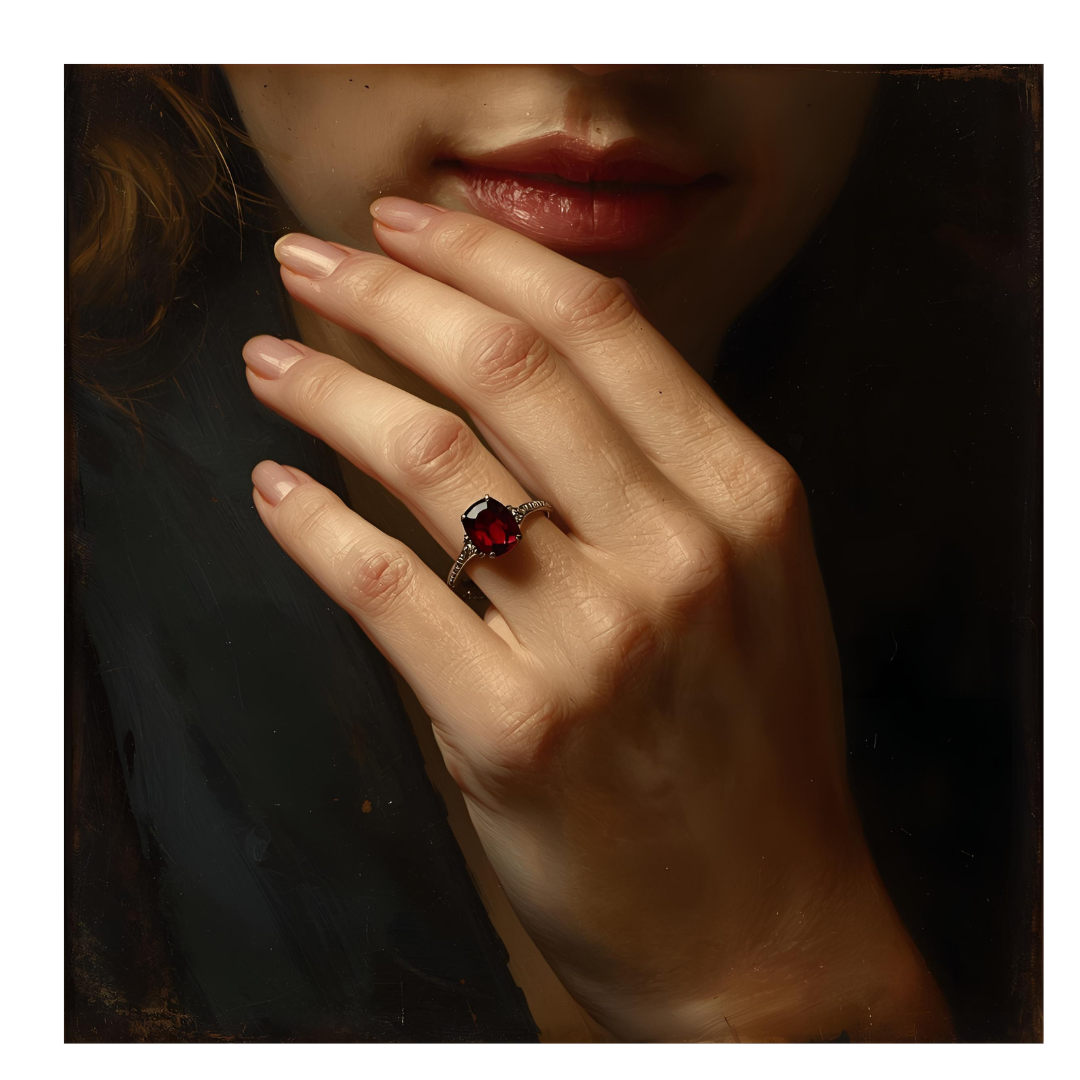
What Wearing a Garnet Ring Reveals: Insights into Its History and Meaning
Of course. Wearing a garnet ring is a statement rich with history, symbolism, and personal meaning. It reveals much about the wearer's taste, intentions, and perhaps even their inner world.
Here’s a deep dive into what a garnet ring reveals, exploring its history and multifaceted meaning.
What It Reveals About the Wearer
At a glance, a garnet ring suggests a person who appreciates depth, history, and understated elegance over flashy trends.
A Taste for the Deep and Meaningful: Unlike the ubiquitous diamond, a garnet is a choice for a connoisseur. It suggests the wearer values rich symbolism, history, and unique beauty over pure ostentation.
Strength and Grounding: The deep red hue evokes a sense of stability, strength, and connection to the earth. It can reveal a wearer who is perceived as (or wishes to be) dependable, resilient, and grounded.
Passionate and Protective Nature: The classic red garnet symbolizes a deep, enduring passion—not just romantic, but also passion for life, creativity, and one's beliefs. Historically, a talisman of protection, it can also indicate a desire for safety and security.
A Connection to History and Romance: Choosing a garnet, a stone with ancient and Victorian significance, might reveal a romantic, nostalgic spirit or an appreciation for antique and vintage styles.
Insights into Its History
The garnet's story is as deep and fiery as its color, stretching back thousands of years.
Ancient Civilizations: Garnet beads have been found in necklaces worn by Egyptians in 3100 B.C., who considered them symbols of life. Pharaohs placed them in their tombs as prized possessions for the afterlife. Romans used them in signet rings to stamp the wax that secured important documents, valuing the stone for its perceived protective qualities.
The Middle Ages: Garnets were immensely popular among the clergy and nobility in Europe. They were believed to protect against poison, wounds, and bad dreams. Crusaders often wore them as protection on their journeys.
The Victorian Era: This was a golden age for garnet jewelry. Queen Victoria's well-documented love for the stone made it immensely fashionable. Jewelry from this period often featured garnets in intricate, dark, romantic designs, typically set in gold and surrounded by smaller stones in a technique called "pavé."
A World Traveler: The Bohemian garnet deposits in the Czech Republic became a major source in the 18th and 19th centuries, leading to a thriving jewelry industry. Meanwhile, garnet birthstone have been found and treasured across Asia and the Americas for centuries.
The Multifaceted Meaning and Symbolism
The meaning of a garnet ring can vary slightly depending on its color and the wearer's intention, but core themes remain.
Commitment and Love:
While not the traditional "engagement ring" stone in the modern sense, garnet has a long history as a stone of devotion. Its deep red symbolizes a lasting, passionate love that is more profound and intimate than the fiery spark of a ruby. It is the traditional gift for a 2nd and 6th wedding anniversary.
Protection and Safe Journey:
This is one of the oldest and most universal meanings. For centuries, garnets were carried as talismans to ward off evil, prevent nightmares, and ensure safety during travel. A garnet ring can be a quiet, constant reminder of security.
Vitality, Passion, and Energy:
The stone's vibrant color is naturally associated with the life force—blood, the heart, and vitality. It is believed to energize the wearer, inspire creativity, and fuel the passion to pursue one's goals.
Truth and Friendship:
In some traditions, garnet is seen as a stone that promotes truth and clarity. It was often exchanged between friends to signify their affection and to ensure they would meet again, making it a symbol of loyal friendship.
Balance and Regeneration:
Associated with the root chakra, garnet is thought to ground spiritual energy into the physical plane, creating a sense of stability and balance. It is also symbolically linked to the idea of regeneration and new beginnings.
A Note on Color
While deep red is the most common, garnets come in a stunning array of colors (green, orange, pink, even color-changing), each adding a subtle nuance:
Green Garnet (Tsavorite or Demantoid): Symbolizes abundance, prosperity, and growth.
Orange Garnet (Spessartite): Associated with confidence and vitality.
Pink/Rhodolite Garnet: Often connected to self-love and compassion.
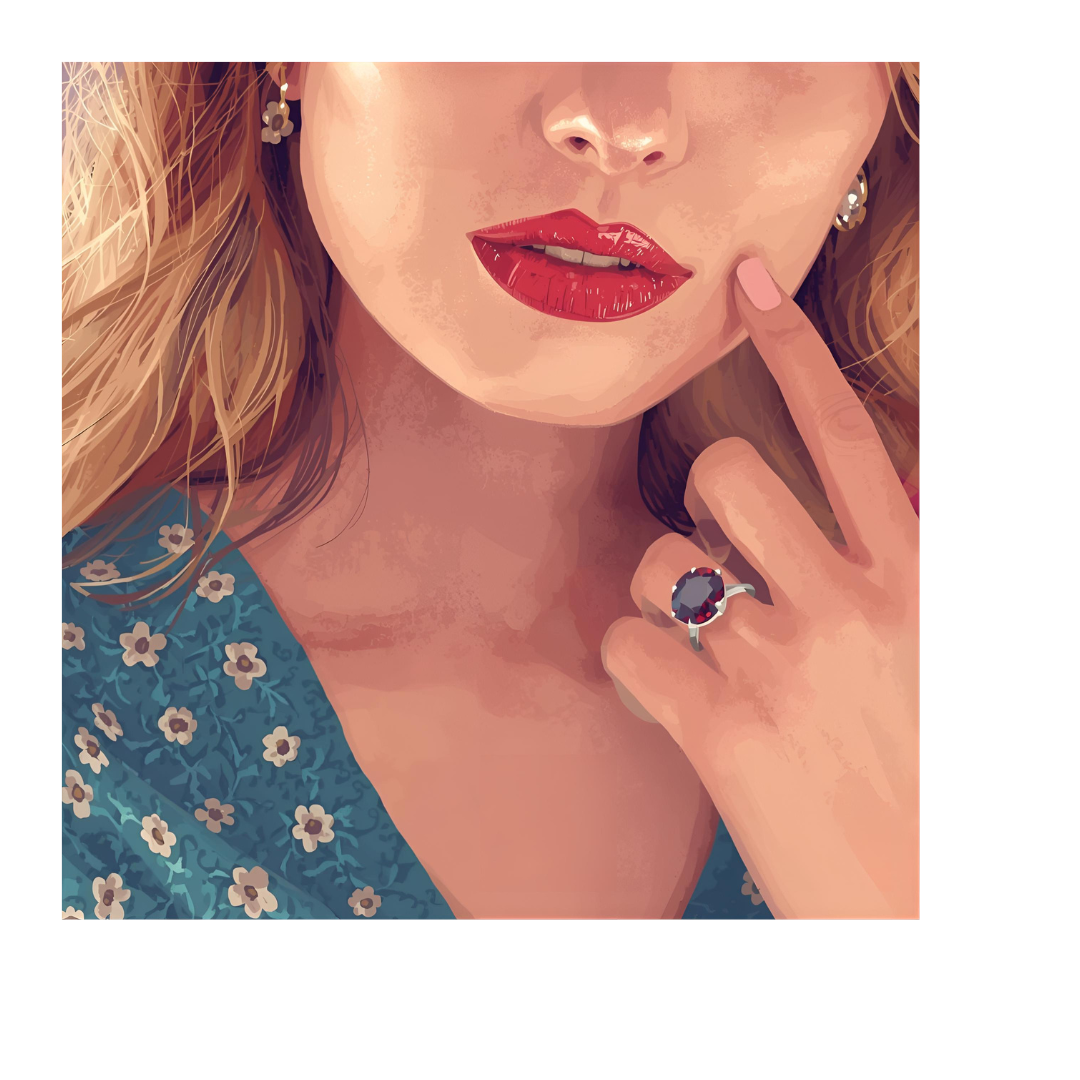
Can You Wear A Garnet Ring Every Day?
Yes, you can wear a garnet ring daily—but it requires careful consideration of the stone’s durability, setting, and maintenance. Here’s what to know:
Factors Affecting Daily Wear
Factor Suitability for Daily Wear
Garnet Hardness Moderate (6.5–7.5 on Mohs scale):
Resists scratches better than opal or pearl.
Vulnerable to harder materials (e.g., quartz in dust, diamond/steel jewelry).
| Setting & Design | Critical for protection:
Bezel/Channel settings: Shield edges from impacts.
Prong settings: Ensure prongs are thick/well-maintained.
High-profile/exposed girdles: Prone to chipping. | Garnet Type | - Green garnets (tsavorite/demantoid) are slightly harder/more durable than red varieties.
Common red garnets (almandine/pyrope) chip more easily. || Lifestyle Risks | Avoid if you:
Work with hands (e.g., construction, gardening).
Expose rings to chemicals (bleach, cleaners) or extreme temperatures. |
Maintenance Tips for Daily Wear
Clean Gently:
Use warm water, mild soap, and a soft brush.
Avoid ultrasonic cleaners (can fracture included stones).
Regular Inspections:
Check prongs/clasps every 6 months.
Replace worn settings promptly.
Safe Storage:
Store separately to prevent scratches from harder gems.
Remove During High-Risk Activities:
Sports, swimming (chlorine), housecleaning, or heavy lifting.
Best Garnets for Daily Wear
Tsavorite/Demantoid (Green):
Higher hardness (7–7.5) and resilience. Ideal in protective settings.
Rhodolite (Purple-Pink):
Good durability for office/light activity.
Avoid Demantoid with "Horsetails":
Inclusions may weaken the stone.
When to Avoid Daily Wear
Antique/Vintage Rings: Thin settings or pre-existing damage.
Soft Inclusions/Fractures: Increases risk of breakage.
Active Lifestyles: Opt for harder gems (sapphire, diamond) if durability is critical.
Verdict
Yes, you can wear it daily if:
It’s set securely (e.g., bezel, low profile).
You avoid harsh impacts/chemicals.
It’s a harder garnet type (e.g., tsavorite).
No, for high-risk activities or delicate rings.
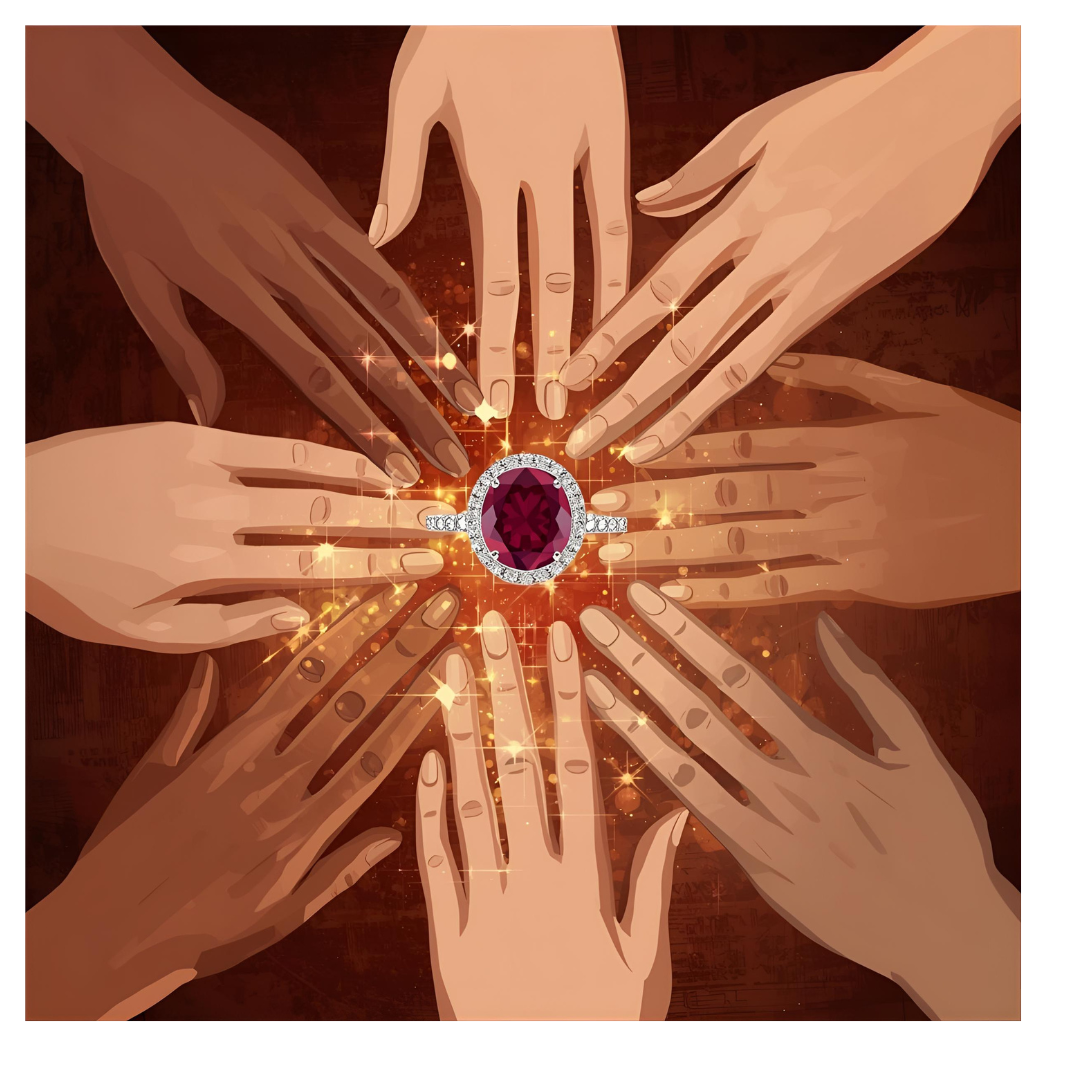
Who Can Wear A Garnet Ring?
Anyone can wear a garnet ring—there are no inherent restrictions based on gender, age, or belief system. However, certain groups may find garnet especially meaningful or beneficial. Here’s a clear guide:
Ideal Wearers & Why
Group Significance Recommended Garnet
January-born Garnet is their birthstone, symbolizing renewal and protection. Deep red (pyrope), green (tsavorite).
Capricorn Aquarius Aligns with their ambitious, innovative energy (Dec 22–Feb 18). Red for vitality, green for growth.
Seeking Protection Garnet repels negativity—ideal for empaths or those in toxic environments. Red almandine or rhodolite.
Manifesting Goals Boosts willpower for career/creative pursuits. Orange spessartine ("mandarin garnet").
Vedic Astrology Balances Rahu (North Node)—worn on the right middle finger by Taurus/Libra. Any untreated garnet ("Gomed").
Who Should Use Caution
Highly sensitive energy: Garnet’s intense vibes may overwhelm. Pair with calming stones (e.g., amethyst).
Active lifestyles: Opt for protective settings (bezel) to prevent chipping (hardness: 6.5–7.5).
Aries/Leo signs: May amplify impulsivity—use in moderation.
Practical Tips for All Wearers
Choose Your Color:
Classic Red: Passion, courage (all skin tones).
Green Tsavorite: Healing, abundance (complements olive/cool skin).
Orange Spessartine: Creativity (pops on warm skin).
Set Intentionally:
Left hand to receive energy (protection, self-love).
Right hand to project energy (confidence, manifestation).
Pair with Metals:
Gold enhances vitality.
Silver softens intensity.
Cultural & Spiritual Notes
Western Traditions: No taboos—garnet is universally auspicious.
Hindu Vedic: Consult an astrologer if wearing for Rahu/Ketu balance.
History: Victorians wore garnet in mourning jewelry; today, it celebrates life.
Final Verdict
Garnet rings suit everyone, but they’re perfect for:
January birthdays or Capricorn/Aquarius signs.
Goal-setters need motivation.
Spiritual seekers desiring grounding/protection.
Simply choose a color and setting that resonates with you.
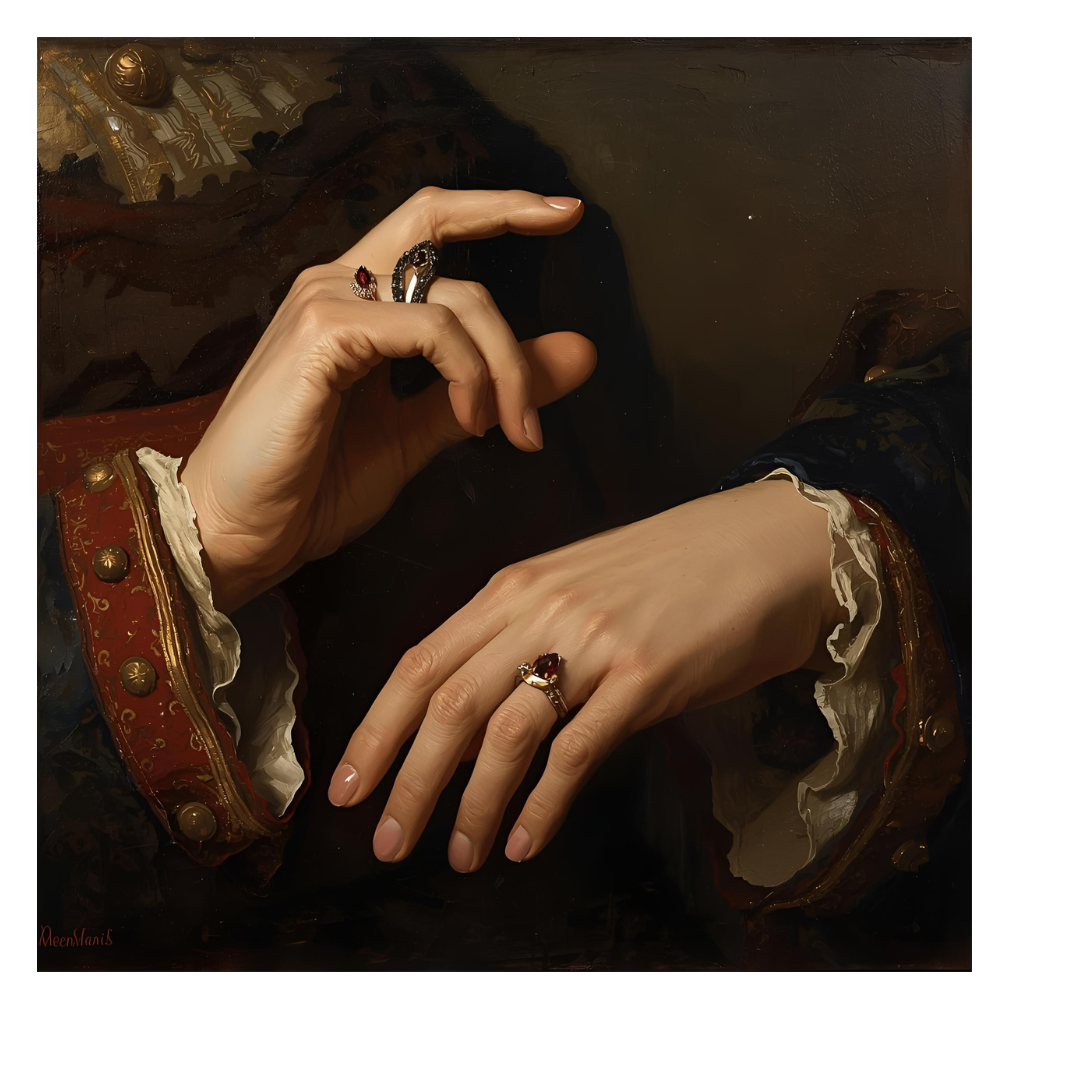
Should You Wear A Garnet On The Left Or Right Hand?
This gets to the heart of the more subtle, personal, and cultural nuances of wearing gemstone jewelry.
The short answer is: There is no universal, rigid rule. The choice of which hand to wear a garnet ring on is largely based on personal preference, cultural background, and the intention behind wearing it.
However, there are several frameworks and traditions you can use to guide your decision. Here’s a breakdown:
1. Cultural and Traditional Guidelines
Left Hand (The "Receiving" Hand): In many cultures, particularly those influenced by Eastern traditions like Ayurveda and Vedic astrology, the left hand is considered the "receiving" hand. It is the hand that draws energy, blessings, and influence inward toward you.
Why you might wear it on the left: If you are wearing a garnet for its metaphysical properties—to attract protection, love, or vitality—wearing it on the left hand is believed to help you better receive those energies.
Right Hand (The "Giving" Hand): Conversely, the right hand is often seen as the "active" or "giving" hand. It is the hand through which you project your energy and intentions out into the world.
Why you might wear it on the right: If you are wearing garnet to project confidence, strength, and grounded energy in your interactions with others, or to manifest your will (e.g., in creative or business pursuits), the right hand might feel more appropriate.
2. Practical and Modern Considerations
Dominant Hand vs. Non-Dominant Hand: This is a very common and practical approach.
Non-Dominant Hand (usually left): Most people choose to wear rings on their non-dominant hand to minimize exposure to wear, tear, and potential damage. A garnet, while durable (6.5-7.5 on the Mohs scale), can still be scratched by harder materials. If you are right-handed, wearing your prized garnet ring on your left hand keeps it safer.
Dominant Hand: You might choose to wear it on your dominant hand if you want it to be more visible or if it simply feels more comfortable and natural there.
Fashion and Personal Style: Ultimately, jewelry is an expression of personal style. Wear it on the hand and finger that you feel looks best and that you enjoy the most. There are no fashion police for gemstone placement!
3. Metaphysical and Intentional Reasons
This is where the "meaning" of the garnet comes most into play. You can choose based on what you want the stone to do for you.
For Internal Work (Left Hand Suggested):
Self-Love & Emotional Healing: To help absorb Garnet's nurturing and passionate energy for yourself.
Protection: To create a shield and protect your personal energy field.
Grounding: To feel more stable, secure, and connected to the physical world.
For External Expression (Right Hand Suggested):
Confidence: To project a sense of strength and vitality in social or professional settings.
Creativity: To actively channel creative energy into your work or art.
Manifestation: To put your intentions and willpower out into the universe.
Summary and Final Recommendation
Intention or Reason Suggested Hand Why?
To Receive Energy (protection, love, calm). The left hand is traditionally the "receiving" hand.
To Project Energy (confidence, creativity, will). The right hand is the "active" or "giving" hand.
For Practical Safety (avoid damage), the Non-Dominant protects the ring from bumps and scratches.
For Maximum Visibility Dominant You gesture more with your dominant hand.
It's an Heirloom/Engagement Ring Left Follows Western tradition for commitment rings.
The best advice is to trust your intuition. Put the ring on one hand, then the other. See which one feels right. Your personal connection to the piece is the most important factor.
There is no "wrong" answer. Whether you choose left or right, you are connecting with a stone of profound history and beautiful meaning.
On which Finger Should A Garnet Be Worn For Females?
Of course. This is a common question, and the answer depends on whether you are following the principles of Vedic astrology or more general crystal healing traditions.
Primary Answer: The Ring Finger
For most purposes, and specifically in Vedic astrology, a garnet (which is the gemstone for the planet Sun or Surya) is recommended to be worn on the ring finger of the right hand.
Here’s a breakdown of the reasoning and the alternatives:
Vedic Astrological Perspective (Most Common)
This is the traditional system that provides specific rules for gemstone wearing.
Finger: Anamika (the Ring Finger)
Hand: Right Hand
Reasoning: In Vedic astrology, the ring finger is governed by the Sun. Wearing the Sun's gemstone (garnet or ruby) on its corresponding finger is believed to amplify the positive energies of the Sun in one's birth chart.
Purpose: It is worn to strengthen the Sun in one's horoscope. A strong Sun is associated with:
Leadership, authority, and confidence
Good health, vitality, and strength
Success in career and government-related fields
Improved relationship with father and figures of authority
Important Astrological Note: It is highly recommended to consult a knowledgeable Vedic astrologer before wearing a garnet. They will analyze your birth chart (kundali) to confirm that strengthening the Sun will be beneficial for you. Wearing the wrong gemstone for your chart can have negative effects.
Crystal Healing & Modern Approach
In modern crystal healing practices, the rules are more flexible and intuitive.
Left Hand vs. Right Hand: It is often said that wearing a crystal on the left hand (the receptive hand) allows you to receive its energies (e.g., confidence, vitality). Wearing it on the right hand (the projective hand) allows you to project its energies outward into the world.
Intention-Based: You can choose the finger based on what you want to achieve:
Ring Finger: Associated with creativity, beauty, and romantic relationships (linked to the Sun and Apollo in Western traditions).
Middle Finger: Associated with life, destiny, and responsibilities. Wearing a grounding stone like garnet here can help you feel more centered and capable.
Index Finger: Associated with authority, ambition, and power (Jupiter's finger). Wearing a garnet here can boost leadership qualities.
Key Considerations for Wearing Garnet:
Metal: Garnet is ideally set in gold or copper to complement its connection to the Sun. Silver is sometimes used in modern jewelry, but is not the traditional astrological metal for the Sun.
Day to Wear: The best day to start wearing a garnet for astrological purposes is a Sunday, during the Shukla Paksha (the waxing phase of the moon).
Purification: It's considered important to purify the gemstone (often with milk, honey, or Ganga water) and energize it with mantras before wearing it for astrological purposes.
Comfort and Style: Ultimately, for non-astrological purposes, the most important factor is that you enjoy wearing it. Choose a finger and a style that you find comfortable and beautiful.
Summary:
Tradition Recommended Finger Hand Reason
Vedic Astrology Ring Finger Right To strengthen the Planet Sun in one's birth chart.
Crystal Healing Ring or Middle Finger Left (to receive) or Right (to project). To attract vitality, confidence, and grounding energy.
Final Advice: If you are seeking astrological benefits, consult an astrologer. If you are wearing it for its beauty and general energetic properties, trust your intuition and wear it in a way that feels right for you.
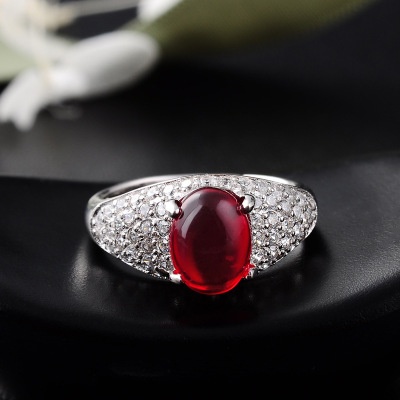
How Much Is A Garnet Ring Worth?
The value of a garnet ring ranges from under $20 to over $20,000+, depending primarily on the garnet type, quality, setting, and brand. Here’s a detailed breakdown:
Key Factors Driving Value
Garnet Type & Color (Most Critical):
Demantoid/Tsavorite (Green): $1,000–$20,000+
Spessartine (Orange): $300–$5,000+
Rhodolite (Purple-Pink): $150–$2,000+
Pyrope/Almandine (Red): $20–$500
Ring Setting & Metal:
10K–14K Gold: Adds $150–$1,000+
Platinum: Adds $500–$3,000+
Sterling Silver: Minimal value ($10–$50)
Brand/Designer Markup:
Mass-Market (Kay, Zales): 50–100% markup over stone value.
Designer (Tiffany, Cartier): 200–500% markup.
Antique/Vintage: Victorian/Art Deco pieces fetch premiums (e.g., $500–$5,000).
Stone Quality:
Size: 1ct vs. 5ct can multiply value 10×.
Clarity: Eye-clean stones cost 2–5× more.
Cut: Precision cuts (e.g., cushion, emerald) add 20–50%.
Price Ranges by Garnet Type
Garnet Type Typical Ring Price Example
Demantoid (Green) $2,000 – $25,000+ 1ct Russian w/horsetail + platinum: $15,000
Tsavorite (Green) $1,000 – $15,000+ 1.5ct Kenyan solitaire + gold: $8,000
Spessartine (Orange) $400 – $7,000+ 2ct "Mandarin" garnet + gold halo: $3,500
Rhodolite (Purple) $150 – $3,000+ 2ct raspberry-pink + silver: $600
Common Red Garnet $20 – $500 3ct almandine + silver: $100
News for Thursday 11 September, 2025
View all news for Thursday 11 September, 2025 on one page
Recent News
- Wednesday 10 September, 2025
- Tuesday 09 September, 2025
- Monday 08 September, 2025
- Sunday 31 August, 2025
- Monday 03 March, 2025

